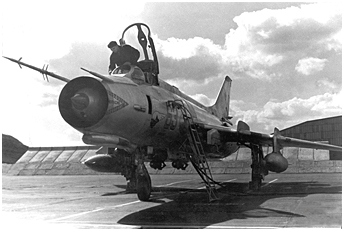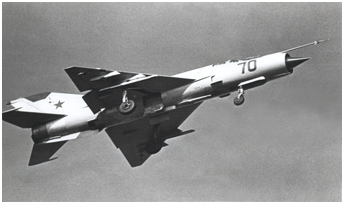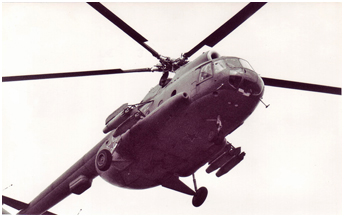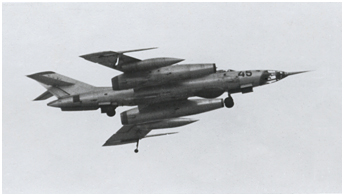Перейти на русский текст здесь
Может бытъ, участвовали этих событиях, или явилисъ свидетелем их. Будъте добры, делайте комментарий или исправлений к тексту, пожалуйста!
Preliminary remarks
The text below was written by an anonymous pilot of the 497.APIB. Unfortunately, we did not get other testimonials about the events described in that story. 30 years old memories have to be corroborated by several persons to be authoritative. There is also apparently some exaggeration at the end. Although we believe that this story is not strictly accurate, we have chosen to publish it in its entirety because it gives a good idea about the nature of large-scale exercises that took place at that time.
Total mobilization
 'A big air exercise was organized during the summer of 1979 by the 16th Air Army - a pilot of the 497.APIB remembers. The different units involved were deployed to unfamiliar GSFG (1)
airfields and performed live firing at the group's ranges (2).
On that day, the complete 497th Fighter-Bomber Aviation Regiment was scrambled with the assigned task to launch a strike on the targets at the Heidehof firing range and subsequently land
at the dispersal airfield near Hassleben, situated at 35 kilometers from the FRG border. There, the aircraft were loaded with the maximum bomb load for a strike by flights, squadron
by squadron, against targets on the Wittstock range. It turned out that, on this day at dawn, almost all units in the air army were scrambled.
Regiments from the Northern Corps landed at airfields belonging to the Southern Corps and vice versa. All ranges within the group appropriate for practical aviation operations were activated.
Fighter-bomber aviation and combat helicopter units struck ground-based targets; fighters worked on intercepting aerial targets and struck ground-based targets as well.
This all took place on the background of a complex operational situation under jamming conditions and with weather (haze and broken overcast) typical for Europe.
The unpleasantness began at takeoff. In our regiment, the aircraft of one of the lead pilots in our group caught fire while being started up in its shelter. The pilot urgently grabbed a spare and the
regimental sortie was not disrupted.
'A big air exercise was organized during the summer of 1979 by the 16th Air Army - a pilot of the 497.APIB remembers. The different units involved were deployed to unfamiliar GSFG (1)
airfields and performed live firing at the group's ranges (2).
On that day, the complete 497th Fighter-Bomber Aviation Regiment was scrambled with the assigned task to launch a strike on the targets at the Heidehof firing range and subsequently land
at the dispersal airfield near Hassleben, situated at 35 kilometers from the FRG border. There, the aircraft were loaded with the maximum bomb load for a strike by flights, squadron
by squadron, against targets on the Wittstock range. It turned out that, on this day at dawn, almost all units in the air army were scrambled.
Regiments from the Northern Corps landed at airfields belonging to the Southern Corps and vice versa. All ranges within the group appropriate for practical aviation operations were activated.
Fighter-bomber aviation and combat helicopter units struck ground-based targets; fighters worked on intercepting aerial targets and struck ground-based targets as well.
This all took place on the background of a complex operational situation under jamming conditions and with weather (haze and broken overcast) typical for Europe.
The unpleasantness began at takeoff. In our regiment, the aircraft of one of the lead pilots in our group caught fire while being started up in its shelter. The pilot urgently grabbed a spare and the
regimental sortie was not disrupted.
 The first stage unfolded normally, but one could sense the complexity of the situation as there were several hundred combat aircraft and helicopters airborne simultaneously.
The nervousness of the control posts was palpable, onboard radios often operated 'atop' one another, some sort of short-circuits were audible but the level of training of the pilots
and the sharpness of the leads helped to keep control of the situation.
We landed at the dispersal airfield where one usually only found the airfield team. While they were readying the aircraft and we were finalizing the mission, we learned that, during the takeoff
of a flight of MiG-27s of the 19.GvAPIB from Brand airfield, the first pair’s lead went off the runway, rolled over and caught fire. The pilot was able to get out of the burning aircraft.
The second regimental sortie occurred in the middle of the day, maneuvers were underway at full tilt, and the maximum number of crews was airborne.
They took off as pairs, gathered into squadrons and followed different routes to the Wittstock range. It was clear from the outset that the 'moment of truth' was upon them and now, it would be
clear who was up to the task.
It was impossible to obtain confirmation from the command post on the occupation of an altitude; there was solid noise on the air. While lead unsuccessfully attempted to communicate with
the command post (and the Supervisor of Flying as well), we - three zveno, twelve aircraft - continued on at an altitude of 300 meters. I was wingman in the first para.
The first stage unfolded normally, but one could sense the complexity of the situation as there were several hundred combat aircraft and helicopters airborne simultaneously.
The nervousness of the control posts was palpable, onboard radios often operated 'atop' one another, some sort of short-circuits were audible but the level of training of the pilots
and the sharpness of the leads helped to keep control of the situation.
We landed at the dispersal airfield where one usually only found the airfield team. While they were readying the aircraft and we were finalizing the mission, we learned that, during the takeoff
of a flight of MiG-27s of the 19.GvAPIB from Brand airfield, the first pair’s lead went off the runway, rolled over and caught fire. The pilot was able to get out of the burning aircraft.
The second regimental sortie occurred in the middle of the day, maneuvers were underway at full tilt, and the maximum number of crews was airborne.
They took off as pairs, gathered into squadrons and followed different routes to the Wittstock range. It was clear from the outset that the 'moment of truth' was upon them and now, it would be
clear who was up to the task.
It was impossible to obtain confirmation from the command post on the occupation of an altitude; there was solid noise on the air. While lead unsuccessfully attempted to communicate with
the command post (and the Supervisor of Flying as well), we - three zveno, twelve aircraft - continued on at an altitude of 300 meters. I was wingman in the first para.
 Suddenly I saw a large group of aircraft sculling along slightly above us to the right on an intersecting course at a range of 500-1000 meters.
Well, the ‘sorting out' had begun!
They also had seen us and began to turn. We initially thought that this group of fighters had decided to set up a dogfight and then it turned out that we had separated from our neighboring
squadron.
We permitted them to move ahead and put together an improvised anti-missile maneuver of the 'Cobra' type in order to stretch out along the route and not interfere with one another at the range.
Since there were no communications as usual on all channels, we went under the clouds, low under the corridors from West Berlin to the FRG. We all understood without having to say a word, closed
up, formed up and assured the commander of a successful event.
En route there some small and large groups of aircraft were sparkling above and off to the side; no one attempted to attack us and we were thankful for that.
At the line to switch to the range channel, everyone switched over and understood that the most serious activities were only just beginning. There was a hubbub there, there wasn’t anything
understandable.
Since we arrived close to the assigned time - the targets were defined ahead of time - and, during wartime, no one would give you the 'I authorize' command, we detoured around the range,
dispersed and selected a window so that no one was ahead and above, and headed to our targets.
Suddenly I saw a large group of aircraft sculling along slightly above us to the right on an intersecting course at a range of 500-1000 meters.
Well, the ‘sorting out' had begun!
They also had seen us and began to turn. We initially thought that this group of fighters had decided to set up a dogfight and then it turned out that we had separated from our neighboring
squadron.
We permitted them to move ahead and put together an improvised anti-missile maneuver of the 'Cobra' type in order to stretch out along the route and not interfere with one another at the range.
Since there were no communications as usual on all channels, we went under the clouds, low under the corridors from West Berlin to the FRG. We all understood without having to say a word, closed
up, formed up and assured the commander of a successful event.
En route there some small and large groups of aircraft were sparkling above and off to the side; no one attempted to attack us and we were thankful for that.
At the line to switch to the range channel, everyone switched over and understood that the most serious activities were only just beginning. There was a hubbub there, there wasn’t anything
understandable.
Since we arrived close to the assigned time - the targets were defined ahead of time - and, during wartime, no one would give you the 'I authorize' command, we detoured around the range,
dispersed and selected a window so that no one was ahead and above, and headed to our targets.
 There were several groups of aircraft over the range at that time, all of them in the haze, and it was unclear who was where doing what.
We approached in flights with a flat dive, dropped our ordnance, pulled out and again were at low altitude. While egressing the range, aircraft on intersecting courses popped up and were visible
if you could turn your head.
We flew some 15 kilometers, went into a climb and took up the assigned altitude.
It became calmer on the air as we approached the airfield; we more or less sorted things out, dispersed and landed.
They readied the aircraft again; there was one more raid on Heidehof, with landing at Grossenhain as dusk was falling.
Then we checked out our wounds and counted the heads of our comrades.
During this long and difficult day, other than the breakdowns and accidents indicated above, there were only three flying incidents in the air army (I recall that there was an ejection from a
MiG-21bis that ingested a bird and something happened at the range when the engine of an aircraft flamed out (3).
Naturally(!), different aircraft types had some shrapnel damage. But,
given the fiasco with control and communications, it is amazing that we got off so easily. I cannot understand to this day whether it was our side that introduced jamming to check the actual
training level of flying personnel, if it was the adversary attempting to hinder the conduct of the exercises, or the interference arose due to a large number of radios operating simultaneously. . .'
There were several groups of aircraft over the range at that time, all of them in the haze, and it was unclear who was where doing what.
We approached in flights with a flat dive, dropped our ordnance, pulled out and again were at low altitude. While egressing the range, aircraft on intersecting courses popped up and were visible
if you could turn your head.
We flew some 15 kilometers, went into a climb and took up the assigned altitude.
It became calmer on the air as we approached the airfield; we more or less sorted things out, dispersed and landed.
They readied the aircraft again; there was one more raid on Heidehof, with landing at Grossenhain as dusk was falling.
Then we checked out our wounds and counted the heads of our comrades.
During this long and difficult day, other than the breakdowns and accidents indicated above, there were only three flying incidents in the air army (I recall that there was an ejection from a
MiG-21bis that ingested a bird and something happened at the range when the engine of an aircraft flamed out (3).
Naturally(!), different aircraft types had some shrapnel damage. But,
given the fiasco with control and communications, it is amazing that we got off so easily. I cannot understand to this day whether it was our side that introduced jamming to check the actual
training level of flying personnel, if it was the adversary attempting to hinder the conduct of the exercises, or the interference arose due to a large number of radios operating simultaneously. . .'
What to think?
With the main firing ranges active at the same time - Wittstock and Heidehof are mentioned and it seems reasonable to think that at least Retzow and Belgern were also involved - and also most of the airfields active, it is hard to believe that such an exercise went unnoticed by the Allied military liaison missions. The USMLM unit history for 1979 mentioned a tri-service (British, French and US missions) coverage of the Wittstock firing range between the 10th and the 27th July during the preparation(?) and the conduct of an 'air power demonstration'. While unidentified - at the time - stores and pods were seen, there was no remark about the level of activity. During the same period, the first Su-24 deployed outside the USSR were photographed at Gross Dölln on 19th July. These aircraft of the 455.BAP from Voronezh took part in the exercise 'Udar 79'. We ignore however if the latter was the global exercise mentioned above. The participation of the Su-24 in the 'air power demonstration' was not emphasized by the USMLM report.
notes
(1) Group of Soviet Forces in Germany.
(2) Understand Northern and Southern corps.
(3) A flame out provoked by smoke ingestion?
 |
Plan du site - Sitemap |  |
